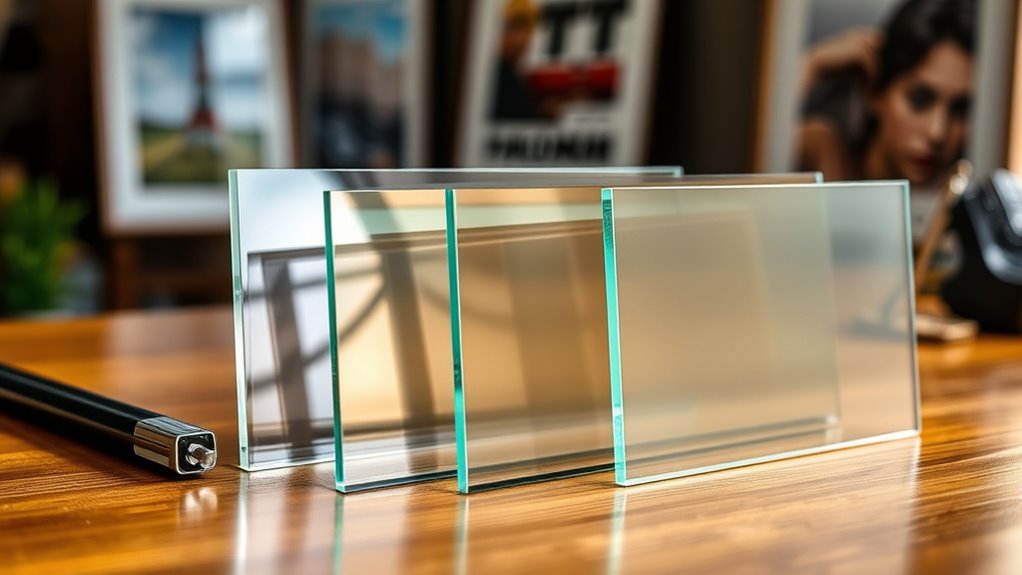When choosing the right glass for framing artwork, consider your display environment and artwork value. Look for options that offer UV protection to prevent fading and glare reduction to improve visibility. Museum glass or anti-glare options are ideal for valuable pieces and bright rooms. Balancing protection and presentation ensures your artwork stays vibrant and protected long-term. Keep exploring to discover how specific glass types can best suit your display needs and enhance your artwork’s longevity.
Key Takeaways
- Assess your display environment to determine if glare reduction or UV protection is more critical.
- Prioritize UV-protective glass to prevent fading and preserve artwork over time.
- Consider museum or anti-reflective glass for enhanced clarity and reduced reflections in brightly lit areas.
- Balance budget with the level of protection and clarity needed, choosing specialized glass if necessary.
- Ensure proper framing and sealing to maximize the protective benefits of your chosen glass.

Selecting the right glass for framing your artwork is vital to protect and showcase your piece effectively. The glass you choose can influence how well your artwork is preserved over time and how it appears to viewers. When considering your options, pay close attention to features like UV protection and glare reduction, as these can make a significant difference in maintaining the integrity and visual appeal of your artwork.
UV protection is vital because ultraviolet rays from sunlight or artificial lighting can cause fading and deterioration of your artwork’s colors and materials over time. Choosing glass with UV filtering capabilities helps block these harmful rays, ensuring your piece retains its vibrancy for years to come. If your artwork will be displayed near windows or in well-lit rooms, investing in UV-protective glass is especially wise. It acts as a barrier, preventing the sun’s rays from penetrating and damaging delicate pigments or paper fibers. This feature is particularly valuable for valuable or sentimental pieces you want to keep in pristine condition.
UV-protective glass preserves artwork’s colors by blocking harmful rays, ideal for valuable or sentimental pieces near windows.
Glare reduction is another key factor to consider. Glare can make viewing difficult and diminish the visual impact of your artwork, especially in brightly lit spaces or under direct light. Glass with glare reduction properties minimizes reflections and unwanted light reflections that can obscure details or distract viewers. If your framing will be placed in areas with strong lighting or near windows, opt for glass that offers glare mitigation. This ensures that viewers can appreciate your artwork clearly without squinting or adjusting their position constantly. It also enhances the overall presentation, making your framed piece more engaging and enjoyable to look at.
There are different types of glass designed to address these needs. Museum glass, for example, often combines UV protection with glare reduction features, providing ideal clarity and preservation. Non-reflective or anti-glare glass options are also available and are particularly effective in high-traffic or brightly lit environments. While these specialized glasses tend to be more expensive than standard glass, the benefits they offer in protecting and presenting your artwork can justify the investment.
Ultimately, selecting the right glass involves balancing your specific display environment, the value of your artwork, and your budget. Prioritize UV protection to prevent fading and glare reduction to improve visibility. Additionally, understanding the impact of proper framing on long-term artwork preservation can guide you in making the best choices. By making an informed choice, you’ll not only safeguard your artwork but also enhance its visual impact, ensuring it continues to be admired for years to come.
Frequently Asked Questions
How Does Glass Thickness Affect Artwork Protection?
You might wonder how glass thickness affects artwork protection. Thicker glass generally offers greater durability, making it more resistant to impacts and scratches. It also helps reduce glare and enhances clarity. Variations in thickness can influence glass durability, with thicker options providing better protection overall. However, keep in mind that increased thickness might add weight, so consider your artwork’s framing setup to guarantee proper support and ideal protection.
Can Anti-Reflective Glass Be Used for All Artwork Types?
Ever wonder if anti-reflective glass suits all artwork? In most cases, yes, but consider the piece’s needs. Anti-reflective glass offers excellent UV filtering and reduces glare, making it ideal for glossy or matte finishes. However, for artworks with textured surfaces or specific conservation needs, other glass types might be better. Always assess your artwork’s material and display environment before choosing anti-reflective glass to guarantee the best protection and presentation.
What Is the Best Glass for Outdoor or Humidity-Prone Areas?
For outdoor or humidity-prone areas, you should choose glass with UV protection and glare reduction. This type of glass helps shield your artwork from harmful UV rays and minimizes reflections, making it easier to view in bright conditions. Look for weather-resistant options like acrylic or specialized glazing designed for outdoor use. These choices safeguard your artwork’s integrity and assure it stays vibrant despite exposure to sunlight and humidity.
How Does Glazing Impact the Long-Term Preservation of Artwork?
Glazing impacts your artwork’s long-term preservation by providing UV protection, which blocks harmful rays that cause fading and deterioration. It also enhances clarity, so your artwork remains vivid and true to its original colors. By selecting glazing with these features, you actively safeguard your art from environmental damage, ensuring it stays beautiful and intact for years to come. Proper glazing is essential for preserving your artwork’s value and visual integrity over time.
Are There Eco-Friendly Glass Options Available for Framing?
You’ll find eco-friendly glass options for framing, including those made from recycled materials and biodegradable options. These alternatives reduce environmental impact and often come with recycling options after use. By choosing glass that incorporates recycled content or biodegradable materials, you help support sustainability efforts. Always check with manufacturers for specific recycling options and eco-friendly certifications, ensuring your framing choices align with your commitment to protecting the environment.
Conclusion
Choosing the right glass is like finding the perfect pair of sunglasses—you want clarity without distortion. When I framed my grandmother’s watercolor, selecting non-reflective glass transformed the piece from dull to vibrant, like opening a window to a sunlit garden. Remember, the right glass protects your artwork and enhances its beauty, making it feel alive. Trust your instincts, and you’ll create a display that’s as clear and enthralling as the art itself.









